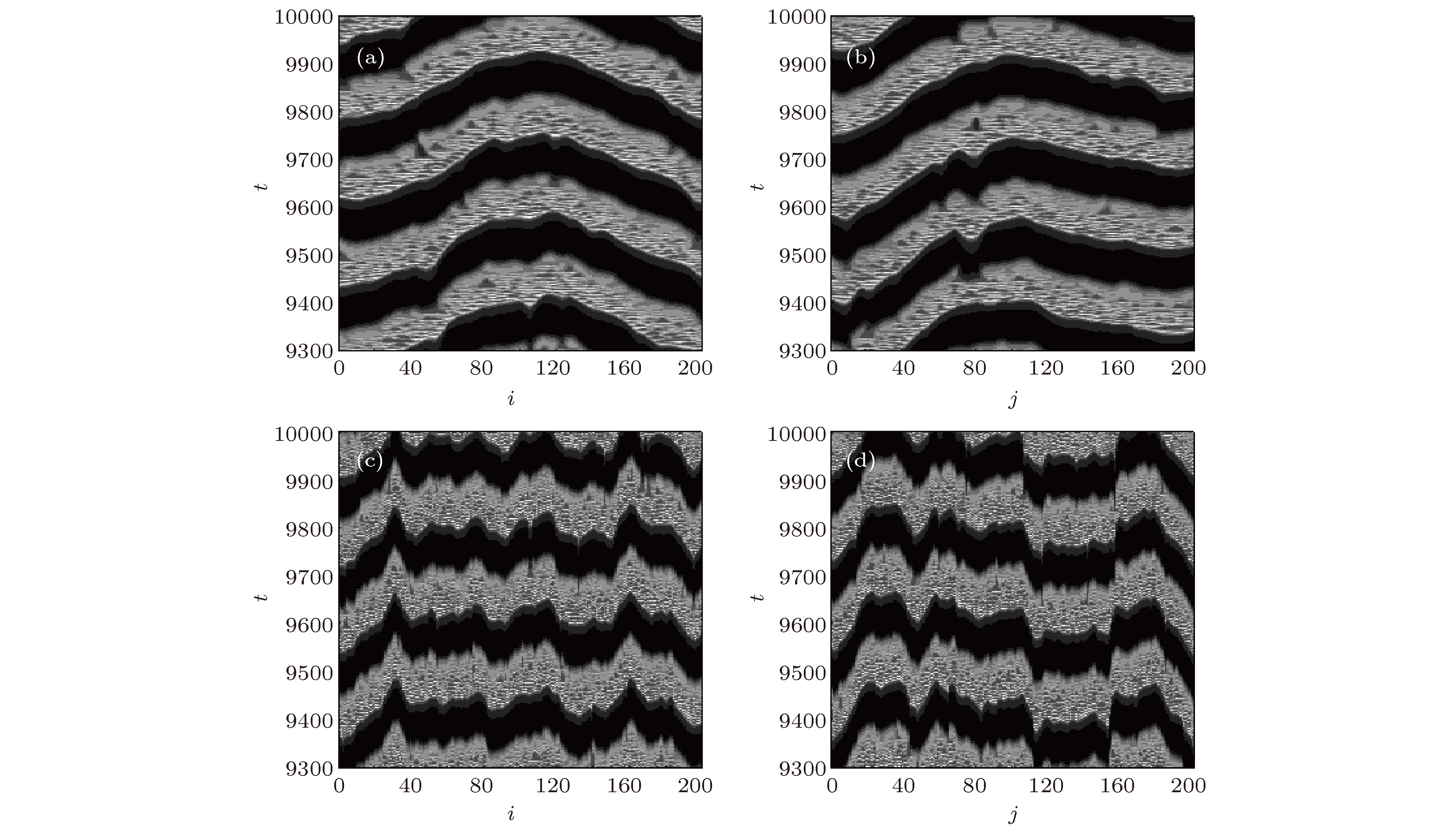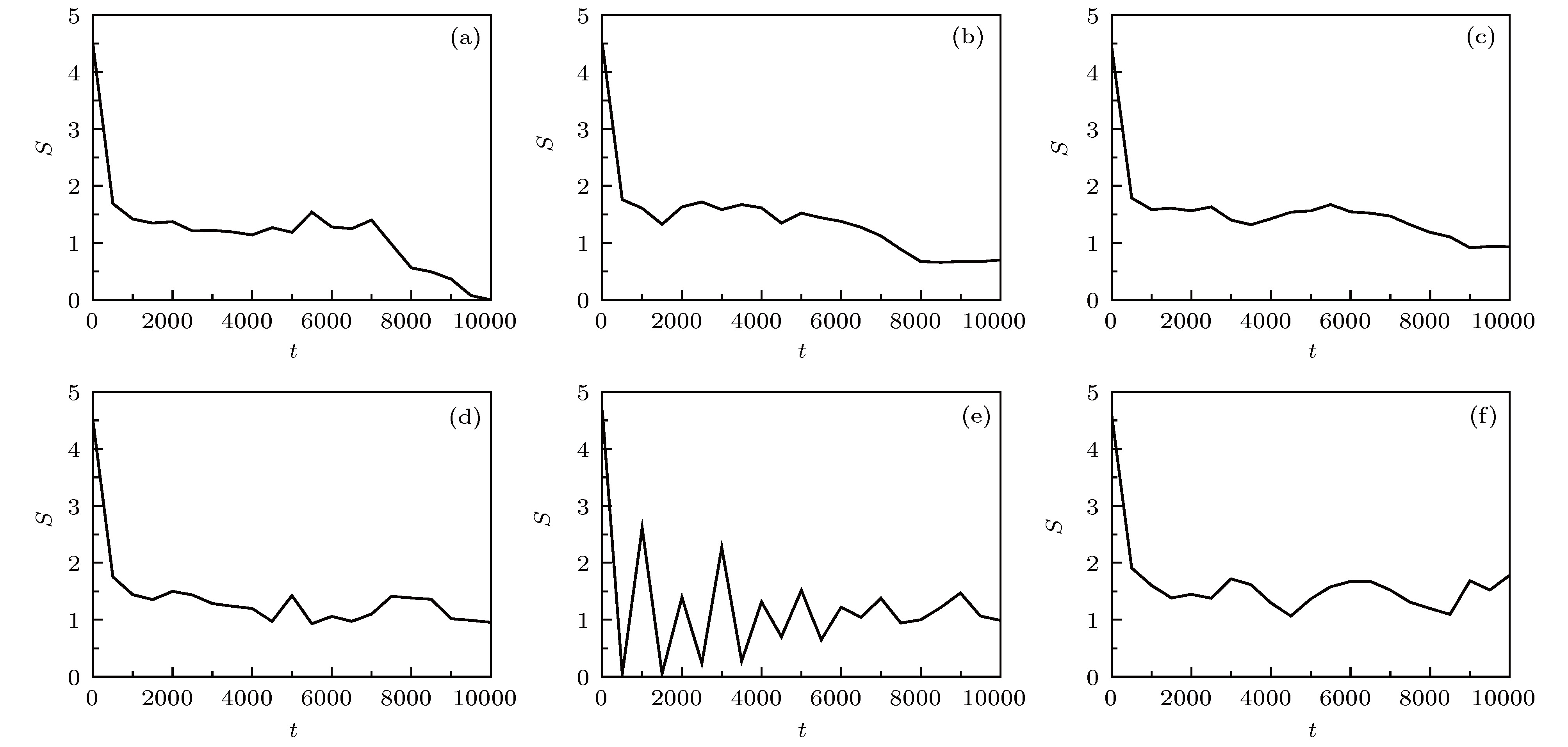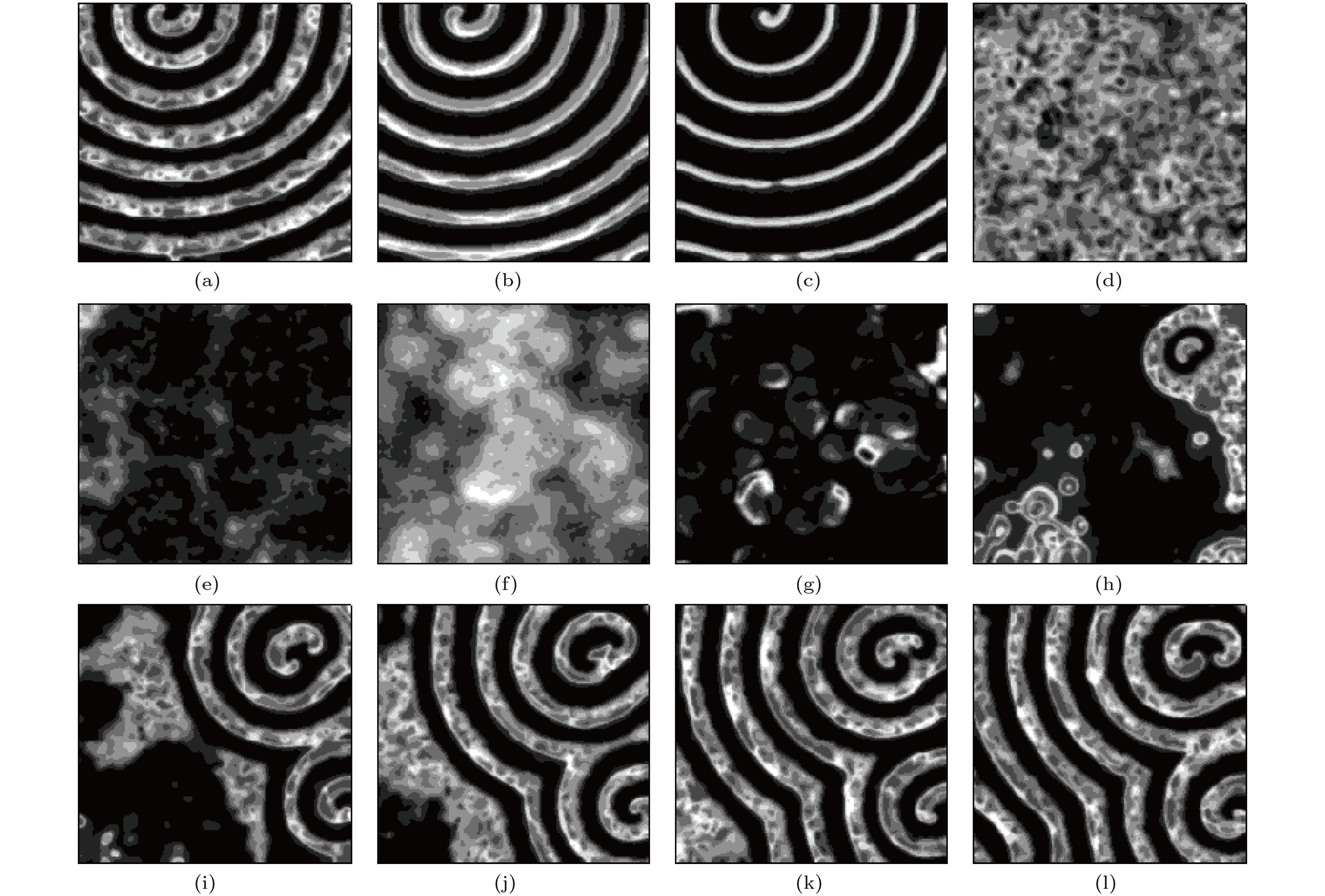-
脑神经网络在一定条件下可以自发出现行波、驻波、螺旋波, 这些有序时空斑图的出现往往与某种神经疾病有关, 但是其产生的机制尚未完全清楚, 如何定量描述这些时空斑图的性质仍需要探索, 为了解决这些问题, 本文采用Hindmarsh-Rose神经元模型研究了具有排斥耦合的二维双耦合层神经元网络从混沌初相位开始演化的动力学行为, 并用改进的集团熵来描述神经元网络的时空斑图. 数值模拟结果表明: 排斥耦合既可以促进有序斑图的形成, 也可以抑制有序斑图的形成. 适当选择排斥和兴奋性耦合强度, 排斥耦合可导致单螺旋波、多螺旋波、行波、螺旋波和靶波与其他态共存、行波与驻波共存等有序斑图出现, 螺旋波、行波出现概率分别达到0.4555和0.1667. 靶波与其他态共存和行波与驻波共存出现概率分别达到0.0389和0.1056, 我们提出的集团熵可以较好区分这些有序斑图和混沌态. 当排斥耦合强度足够大时, 网络一般处于混沌态. 当网络处于弱耦合状态时, 通过计算集团熵发现网络可以出现很大集团, 这些结果有助于理解在实验中观察到的现象, 从而能为神经疾病治疗提供帮助.
-
关键词:
- 螺旋波 /
- 驻波 /
- Hindmarsh-Rose神经元 /
- 排斥耦合
Traveling waves, standing waves, and spiral waves occur spontaneously in the brain neural network in some brain states. The occurrence of these ordered spatiotemporal patterns is often related to some neurological diseases. However, the mechanisms behind the generation of the ordered pattern are not fully understood. How to quantitatively describe the nature of these spatiotemporal patterns still needs further exploring. In order to solve these problems, the Hindmarsh-Rose neuron model is used to study the dynamic behavior of the two-dimensional (2D) neuronal network with double-coupling layer, which is composed of nearest-neighbor excitatory coupling and long-range repulsive coupling layers and evolves from an initial state with a random phase distribution. An improved cluster entropy is proposed to describe the spatiotemporal pattern of the neuronal network. The numerical simulation results show that the repulsive coupling can either promote the formation of ordered patterns or suppress the formation of ordered patterns. When the repulsive coupling strength and excitatory coupling strength are appropriately selected, the chaotic network can spontaneously generate single spiral wave, multiple spiral wave, traveling wave, the coexistence of spiral wave and others wave state, the coexistence of target wave and others wave state, the coexistence of traveling wave and standing wave, etc. The probability with which spiral wave and traveling wave occur reach 0.4555 and 0.1667 respectively. The probability with which target wave and other states co-occur, and the probability with which the traveling wave and the standing wave co-occur, are 0.0389 and 0.1056, respectively. These ordered wave patterns and chaotic states can be distinguished by using the proposed cluster entropy. When the repulsive coupling strength is large enough, the neuronal network is generally in chaotic state. It is found by calculating cluster entropy that a large cluster can appear in the neuronal network when the excitatory coupling strength and repulsive coupling strength are both weak. These results can conduce to understanding the self-organization phenomena occurring in the experiments and also to treating various neurological diseases.-
Keywords:
- spiral wave /
- standing wave /
- Hindmarsh-Rose neuron /
- repulsive coupling
[1] Larionova Y, Egorov O, Cabrera-Granado E, Esteban-Martin A 2005 Phys. Rev. A 72 033825
 Google Scholar
Google Scholar
[2] Plapp B P, Egolf D A, Bodenschatz E, Pesch W 1998 Phys. Rev. Lett. 81 5334
 Google Scholar
Google Scholar
[3] Bär M, Gottschalk N, Eiswirth M, Ertl G 1994 J. Phys. Chem. B 100 1202
 Google Scholar
Google Scholar
[4] Müller S C, Plesser T, Hess B 1985 Science 230 661
 Google Scholar
Google Scholar
[5] Vanag V K, Epstein I R 2001 Science 294 835
 Google Scholar
Google Scholar
[6] Davidenko J M, Pertsov A V, Salomonsz R, Baxter W, Jalife J 1992 Nature 355 349
 Google Scholar
Google Scholar
[7] Huang X Y, Xu W F, Liang J M, Takagaki K, Gao X, Wu J Y 2010 Neuron 68 978
 Google Scholar
Google Scholar
[8] Huang X Y, Troy W C, Yang Q, Ma H T, Laing C R, Schiff S J, Wu J Y 2004 J. Neurosci. 24 9897
 Google Scholar
Google Scholar
[9] Viventi J, Kim D H, Vigeland L, Frechette E S, Blanco J A, Kim Y S, Avrin A E, et al. 2011 Nat. Neurosci. 14 1599
[10] Perc M 2007 Chaos, Solitons Fractals 31 280
 Google Scholar
Google Scholar
[11] Qin H X, Ma J, Wang C N, Chu R T 2014 Sci. China: Phys. Mech. Astron. 57 1918
 Google Scholar
Google Scholar
[12] 汪芃, 李倩昀, 黄志精, 唐国宁 2018 物理学报 67 170501
 Google Scholar
Google Scholar
Wang P, Li Q Y, Huang Z J, Tang G N 2018 Acta Phys. Sin. 67 170501
 Google Scholar
Google Scholar
[13] Lip G Y H, Fauchier L, Freedman S B, Gelder V I, Natale A, Gianni C, et al. 2016 Nat. Rev. Dis. Primers 2 16016
 Google Scholar
Google Scholar
[14] Yengi D, Tinsley M R, Showalter K 2018 Chaos 28 045114
 Google Scholar
Google Scholar
[15] Wang Q Y, Chen G R, Perc M 2011 PloS One 6 e15851
 Google Scholar
Google Scholar
[16] Vreeswijk C V, Abbott L F, Ermentrout G B 1994 J. Comput. Neurosci. 1 313
 Google Scholar
Google Scholar
[17] Leyva I, Sendiña-Nadal I, Almendral J A, Sanjuán M A F 2006 Phys. Rev. E 74 056112
 Google Scholar
Google Scholar
[18] Scholkmann F 2015 J. Integr. Neurosci. 14 135
 Google Scholar
Google Scholar
[19] Veeraraghavan R, Lin J, Hoeker G S, Keener J P, Robert G. Gourdie R G, Poelzing S 2015 Pflug. Arch Eur. J. Physiol. 467 2093
 Google Scholar
Google Scholar
[20] Copene E D, Keener J P 2008 J. Math. Biol. 57 265
 Google Scholar
Google Scholar
[21] Shen J, Zhang J H, Xiao H, Wu J M, He K M, Lv Z Z, Li Z J, Xu M, Zhang Y Y 2018 Cell Death and Dis. 9 81
 Google Scholar
Google Scholar
[22] Ma J, Tang J 2017 Nonlinear Dyn. 89 1569
 Google Scholar
Google Scholar
[23] Weinberg S H 2017 Chaos 27 093908
 Google Scholar
Google Scholar
[24] Shlens J, Field G D, Gauthier J L, Grivich M I, Petrusca D, Sher A, Litke A M, Chichilnisky E J 2006 J. Neurosci. 26 8254
 Google Scholar
Google Scholar
[25] Marre O, Boustani S E, Frégnac Y, Destexhe A 2009 Phys. Rev. Lett. 102 138101
 Google Scholar
Google Scholar
[26] Nghiem T A, Telenczuk B, Marre O, Destexhe A, Ferrari U 2018 Phys. Rev. E 98 012402
 Google Scholar
Google Scholar
[27] Jung P, Wang J, Wackerbauer R, Showalter K 2000 Phys. Rev. E 61 2095
 Google Scholar
Google Scholar
[28] Hindmarsh J L, Rose R M 1984 Pro. R. Soc. Lond. B 221 87
 Google Scholar
Google Scholar
[29] Adhikari B M, Prasad A, Dhamala M 2011 Chaos 21 023116
 Google Scholar
Google Scholar
[30] Nunez P L, Srinivasan R 2006 Clin. Neurophysiol. 117 2424
 Google Scholar
Google Scholar
[31] Müller M F, Rummel C, Goodfellow M, Schindler K 2014 Brain Connectivity 4 131
 Google Scholar
Google Scholar
[32] Schneidman E, Berry M J, Segev R, Bialek W 2006 Nature 440 1007
 Google Scholar
Google Scholar
-
图 1 不同耦合强度下的神经元
${x_{i,j}}$ 变量斑图, 每一个图下方为相应斑图的熵值 (a)$w = 0,\;g = {\rm{0}}$ ; (b)$w = 0.{\rm{17}},\;g = {\rm{0}}.{\rm{3}}$ ; (c)$w = 0.05,\;g = 1.2$ ; (d)$w = 0.05,\;g = 1.1 $ ; (e)$w = 0.07,\;g = 1.3$ ; (f)$w = 0.0{\rm{9}},\;g = 1.{\rm{9}}$ ; (g) w = 0.05,$g = 1.0$ ; (h)$w = 0.01,\;g = 0.1$ ; (i)$w = 0,\;g = {\rm{0}}.{\rm{1}}$ ; (j)$w = 0.03,\;g = 1.0$ ; (k)$w = 0.07,\;g = 0.4$ ; (l) w = 0.05,$g = 0.4$ Fig. 1. Pattern of the variable
${x_{i,j}}$ for different values of coupling strength. Entropy of the corresponding pattern is given underneath each panel: (a)$w = 0,\;g = {\rm{0}}$ ; (b)$w = 0.{\rm{17}},\;g = {\rm{0}}.{\rm{3}}$ ; (c)$w = 0.05,\;g = 1.2$ ; (d)$w = 0.05,\;g = 1.1 $ ; (e)$w = 0.07,\;g = 1.3$ ; (f)$w = 0.0{\rm{9}},\;g = 1.{\rm{9}}$ ; (g)$w = 0.05,\;g = 1.0$ ; (h)$w = 0.01,\;g = 0.1$ ; (i)$w = 0,\;g = {\rm{0}}.{\rm{1}}$ ; (j)$w = 0.03,\;g = 1.0$ ; (k) w$ = 0.07,\;g = 0.4$ ; (l)$w = 0.05,\;g = 0.4$ .图 2 不同耦合强度下一行和一列格点的
${x_{i,j}}$ 变量时空斑图 (a)$w = 0.05,\;g = 1.0$ ; (b)$w = 0.05,\;g = 1.0$ ; (c) w =$ 0.01,\;g = 0.1$ ; (d)$w = 0.01,\;g = 0.1$ Fig. 2. Spatiotemporal pattern of the variable
${x_{i,j}}$ of a row and a column of grid points for different values of coupling strength: (a)$w = 0.05,\;g = 1.0$ ; (b)$w = 0.05,\;g = 1.0$ ; (c)$w = 0.01,\;g = 0.1$ ; (d)$w = 0.01,\;g = 0.1$ .图 3 不同耦合强度下网络的集团熵随时间变化 (a)
$w = 0.05,\;g = 1.2$ ; (b)$w = 0.05,\;g = 1.1$ ; (c)$w = 0.07,\;g = 1.3$ ; (d)$w = 0.05,\;g = 1.0$ ; (e)$w = 0.01,\;g = 0.1$ ; (f)$w = 0.05,\;g = 0.4$ .Fig. 3. Time evolution of the cluster entropy of the network for different values of coupling strength: (a)
$w = 0.05,\;g = 1.2$ ; (b)$w = 0.05,\;g = 1.1$ ; (c)$w = 0.07,\;g = 1.3$ ; (d)$w = 0.05,\;g = 1.0$ ; (e)$w = 0.01,\;g = 0.1$ ; (f)$w = 0.05,\;g = 0.4$ .图 6 在
$g = 1.2$ 和不同耦合强度w下不同时刻的${x_{i,j}}$ 变量斑图 (a)$w = - 0.15$ ,$t = 0$ ; (b)$w = - 0.15$ ,$t = 1000$ ; (c)$w = - 0.15$ ,$t = 2000$ ; (d)$w = - 0.15$ ,$t = 4000$ ; (e)$w = - 0.15$ ,$t = 6000$ ; (f)$w = - 0.15$ ,$t = 8000$ ; (g)$w = - 0.15$ ,$t = 10000$ ; (h)$w = 0.05$ ,$t = 12000$ ; (i)$w = 0.05$ ,$t = 14000$ ; (j)$w = 0.05$ ,$t = 16000$ ; (k)$w = 0.05$ ,$t = 18000$ ; (l)$w = 0.05$ ,$t = 20000$ .Fig. 6. Pattern of the
${x_{i,j}}$ variable at different time moments for g = 1.2 and different values of coupling strength w: (a)$w = - 0.15$ ,$t = 0$ ; (b)$w = - 0.15$ ,$t = 1000$ ; (c)$w = - 0.15$ ,$t = 2000$ ; (d)$w = - 0.15$ ,$t = 4000$ ; (e)$w = - 0.15$ ,$t = 6000$ ; (f) w = –0.15,$t = 8000$ ; (g)$w = - 0.15$ ,$t = 10000$ ; (h)$w = 0.05$ ,$t = 12000$ ; (i)$w = 0.05$ ,$t = 14000$ ; (j)$w = 0.05$ ,$t = 16000$ ; (k)$w = 0.05$ ,$t = 18000$ ; (l)$w = 0.05$ ,$t = 20000$ . -
[1] Larionova Y, Egorov O, Cabrera-Granado E, Esteban-Martin A 2005 Phys. Rev. A 72 033825
 Google Scholar
Google Scholar
[2] Plapp B P, Egolf D A, Bodenschatz E, Pesch W 1998 Phys. Rev. Lett. 81 5334
 Google Scholar
Google Scholar
[3] Bär M, Gottschalk N, Eiswirth M, Ertl G 1994 J. Phys. Chem. B 100 1202
 Google Scholar
Google Scholar
[4] Müller S C, Plesser T, Hess B 1985 Science 230 661
 Google Scholar
Google Scholar
[5] Vanag V K, Epstein I R 2001 Science 294 835
 Google Scholar
Google Scholar
[6] Davidenko J M, Pertsov A V, Salomonsz R, Baxter W, Jalife J 1992 Nature 355 349
 Google Scholar
Google Scholar
[7] Huang X Y, Xu W F, Liang J M, Takagaki K, Gao X, Wu J Y 2010 Neuron 68 978
 Google Scholar
Google Scholar
[8] Huang X Y, Troy W C, Yang Q, Ma H T, Laing C R, Schiff S J, Wu J Y 2004 J. Neurosci. 24 9897
 Google Scholar
Google Scholar
[9] Viventi J, Kim D H, Vigeland L, Frechette E S, Blanco J A, Kim Y S, Avrin A E, et al. 2011 Nat. Neurosci. 14 1599
[10] Perc M 2007 Chaos, Solitons Fractals 31 280
 Google Scholar
Google Scholar
[11] Qin H X, Ma J, Wang C N, Chu R T 2014 Sci. China: Phys. Mech. Astron. 57 1918
 Google Scholar
Google Scholar
[12] 汪芃, 李倩昀, 黄志精, 唐国宁 2018 物理学报 67 170501
 Google Scholar
Google Scholar
Wang P, Li Q Y, Huang Z J, Tang G N 2018 Acta Phys. Sin. 67 170501
 Google Scholar
Google Scholar
[13] Lip G Y H, Fauchier L, Freedman S B, Gelder V I, Natale A, Gianni C, et al. 2016 Nat. Rev. Dis. Primers 2 16016
 Google Scholar
Google Scholar
[14] Yengi D, Tinsley M R, Showalter K 2018 Chaos 28 045114
 Google Scholar
Google Scholar
[15] Wang Q Y, Chen G R, Perc M 2011 PloS One 6 e15851
 Google Scholar
Google Scholar
[16] Vreeswijk C V, Abbott L F, Ermentrout G B 1994 J. Comput. Neurosci. 1 313
 Google Scholar
Google Scholar
[17] Leyva I, Sendiña-Nadal I, Almendral J A, Sanjuán M A F 2006 Phys. Rev. E 74 056112
 Google Scholar
Google Scholar
[18] Scholkmann F 2015 J. Integr. Neurosci. 14 135
 Google Scholar
Google Scholar
[19] Veeraraghavan R, Lin J, Hoeker G S, Keener J P, Robert G. Gourdie R G, Poelzing S 2015 Pflug. Arch Eur. J. Physiol. 467 2093
 Google Scholar
Google Scholar
[20] Copene E D, Keener J P 2008 J. Math. Biol. 57 265
 Google Scholar
Google Scholar
[21] Shen J, Zhang J H, Xiao H, Wu J M, He K M, Lv Z Z, Li Z J, Xu M, Zhang Y Y 2018 Cell Death and Dis. 9 81
 Google Scholar
Google Scholar
[22] Ma J, Tang J 2017 Nonlinear Dyn. 89 1569
 Google Scholar
Google Scholar
[23] Weinberg S H 2017 Chaos 27 093908
 Google Scholar
Google Scholar
[24] Shlens J, Field G D, Gauthier J L, Grivich M I, Petrusca D, Sher A, Litke A M, Chichilnisky E J 2006 J. Neurosci. 26 8254
 Google Scholar
Google Scholar
[25] Marre O, Boustani S E, Frégnac Y, Destexhe A 2009 Phys. Rev. Lett. 102 138101
 Google Scholar
Google Scholar
[26] Nghiem T A, Telenczuk B, Marre O, Destexhe A, Ferrari U 2018 Phys. Rev. E 98 012402
 Google Scholar
Google Scholar
[27] Jung P, Wang J, Wackerbauer R, Showalter K 2000 Phys. Rev. E 61 2095
 Google Scholar
Google Scholar
[28] Hindmarsh J L, Rose R M 1984 Pro. R. Soc. Lond. B 221 87
 Google Scholar
Google Scholar
[29] Adhikari B M, Prasad A, Dhamala M 2011 Chaos 21 023116
 Google Scholar
Google Scholar
[30] Nunez P L, Srinivasan R 2006 Clin. Neurophysiol. 117 2424
 Google Scholar
Google Scholar
[31] Müller M F, Rummel C, Goodfellow M, Schindler K 2014 Brain Connectivity 4 131
 Google Scholar
Google Scholar
[32] Schneidman E, Berry M J, Segev R, Bialek W 2006 Nature 440 1007
 Google Scholar
Google Scholar
计量
- 文章访问数: 10619
- PDF下载量: 75
- 被引次数: 0








































 下载:
下载:













































































